 Technology peripherals
Technology peripherals
 AI
AI
 Exploring Siamese networks using contrastive loss for image similarity comparison
Exploring Siamese networks using contrastive loss for image similarity comparison
Exploring Siamese networks using contrastive loss for image similarity comparison
Introduction
In the field of computer vision, accurately measuring image similarity is a critical task with a wide range of practical applications. From image search engines to facial recognition systems and content-based recommendation systems, the ability to effectively compare and find similar images is important. The Siamese network combined with contrastive loss provides a powerful framework for learning image similarity in a data-driven manner. In this blog post, we will dive into the details of Siamese networks, explore the concept of contrastive loss, and explore how these two components work together to create an effective image similarity model. First, the Siamese network consists of two identical subnetworks that share the same weights and parameters. Each sub-network encodes input images into feature vectors that capture key features of the image. We then use a contrastive loss to measure the similarity between the two input images. The contrastive loss is based on the Euclidean distance metric and adopts a restriction term to ensure that the distance between samples of the same class is smaller than the distance between samples of different classes. Through backpropagation and optimization algorithms, Siamese networks are able to automatically learn feature representations, making the ability to resemble images very important. The innovation of this model lies in its ability to learn relatively few samples in the training set and transfer them to the training set through transfer learning. Neural network architecture for measuring similarity between pairs of input samples. The term "Siamese" comes from the concept of a network architecture consisting of two identically structured Siamese neural networks that share the same set of weights. Each network processes one of the samples from the corresponding input and determines the similarity or dissimilarity between them by comparing their outputs. Each sample in the Siamese network deals with the similarity or dissimilarity between input samples from corresponding input samples. This similarity measure can be determined by comparing their outputs. Siamese networks are commonly used for recognition and verification tasks, such as face recognition, fingerprint recognition, and signature verification. It can automatically learn the similarities between input samples and make decisions based on training data. With a Siamese network, each network processes one of the corresponding input samples and compares their outputs to determine how similar or dissimilar they are.
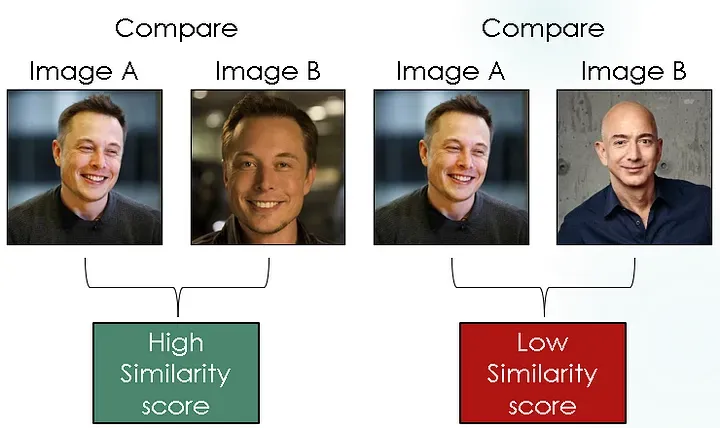
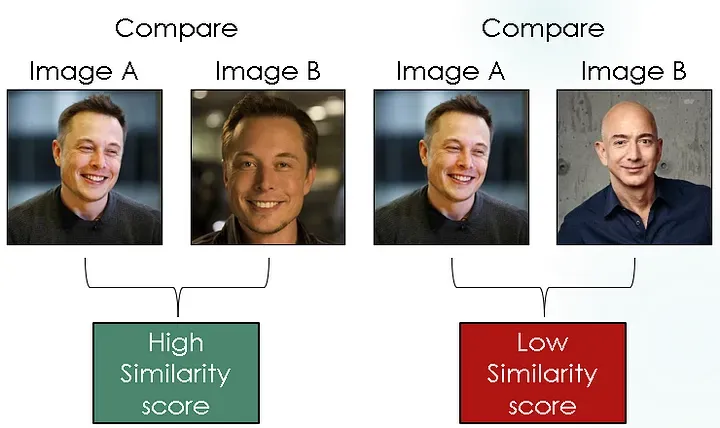
- 共享网络:共享网络是Siamese架构的核心组件。它负责从输入样本中提取有意义的特征表示。共享网络包含神经单元的层,例如卷积层或全连接层,用于处理输入数据并生成固定长度的embedding向量。通过在孪生网络之间共享相同的权重,模型学会为相似的输入提取相似的特征,从而实现有效的比较。
- 相似性度:一旦输入由共享网络处理,就会使用相似性度量来比较生成的embedding,并测量两个输入之间的相似性或不相似性。相似度度量的选择取决于特定任务和输入数据的性质。常见的相似性度量包括欧氏距离、余弦相似度或相关系数。相似性度量量化了embedding之间的距离或相关性,并提供了输入样本之间相似性的度量。
- 对比损失函数:为了训练Siamese网络,采用了对比损失函数。对比损失函数鼓励网络为相似的输入生成距离更近的embedding,而为不相似的输入生成距离更远的embedding。当相似对之间的距离超过一定阈值或不相似对之间的距离低于另一个阈值时,对比损失函数对模型进行惩罚。对比损失函数的确切制定取决于所选的相似性度量和相似对与不相似对之间的期望边际。
在训练过程中,Siamese网络学会优化其参数以最小化对比损失,并生成能够有效捕捉输入数据的相似性结构的判别性embedding。
对比损失函数
对比损失是Siamese网络中常用于学习输入样本对之间相似性或不相似性的损失函数。它旨在以这样一种方式优化网络的参数,即相似的输入具有在特征空间中更接近的embedding,而不相似的输入则被推到更远的位置。通过最小化对比损失,网络学会生成能够有效捕捉输入数据的相似性结构的embedding。
为了详细了解对比损失函数,让我们将其分解为其关键组件和步骤:
- 输入对:对比损失函数作用于输入样本对,其中每对包含一个相似或正例和一个不相似或负例。这些对通常在训练过程中生成,其中正例对代表相似实例,而负例对代表不相似实例。
- embedding:Siamese网络通过共享网络处理每个输入样本,为配对中的两个样本生成embedding向量。这些embedding是固定长度的表示,捕捉输入样本的基本特征。
- 距离度量:使用距离度量,如欧氏距离或余弦相似度,来衡量生成的embedding之间的不相似性或相似性。距离度量的选择取决于输入数据的性质和任务的具体要求。
- 对比损失计算:对比损失函数计算每对embedding的损失,鼓励相似对具有更小的距离,而不相似对具有更大的距离。对比损失的一般公式如下:L = (1 — y) * D² + y * max(0, m — D)
其中:
- L:对于一对的对比损失。
- D:embedding之间的距离或不相似性。
- y:标签,指示配对是否相似(相似为0,不相似为1)。
- m:定义不相似性阈值的边际参数。
损失项 `(1 — y) * D²` 对相似对进行惩罚,如果它们的距离超过边际(m),则鼓励网络减小它们的距离。项 `y * max(0, m — D)²` 对不相似对进行惩罚,如果它们的距离低于边际,则推动网络增加它们的距离。
- 损失的汇总:为了获得整个输入对批次的整体对比损失,通常会对所有对之间的个体损失进行平均或求和。汇总方法的选择取决于特定的训练目标和优化策略。
通过通过梯度下降优化方法(例如反向传播和随机梯度下降)最小化对比损失,Siamese网络学会生成能够有效捕捉输入数据的相似性结构的判别性embedding。对比损失函数在训练Siamese网络中发挥着关键作用,使其能够学习可用于各种任务,如图像相似性、人脸验证和文本相似性的有意义表示。对比损失函数的具体制定和参数可以根据数据的特性和任务的要求进行调整。
在 PyTorch 中的孪生神经网络
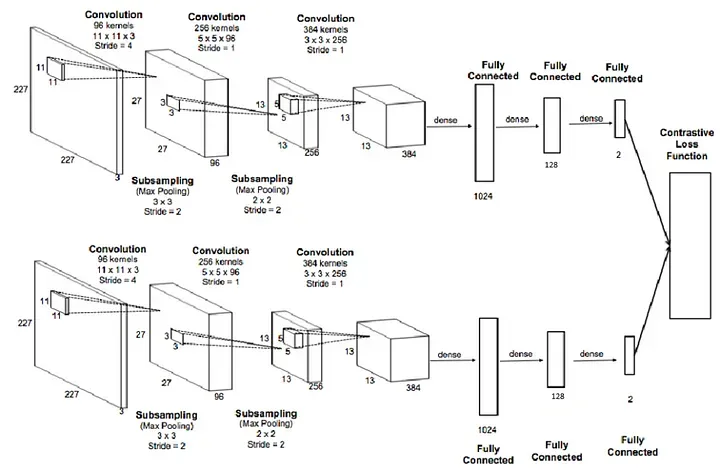
1. 数据集创建
我们使用的数据集来自来自 :
http://vision.stanford.edu/aditya86/ImageNetDogs/
def copy_files(source_folder,files_list,des):for file in files_list:source_file=os.path.join(source_folder,file)des_file=os.path.join(des,file)shutil.copy2(source_file,des_file)print(f"Copied {file} to {des}")return def move_files(source_folder,des):files_list=os.listdir(source_folder)for file in files_list:source_file=os.path.join(source_folder,file)des_file=os.path.join(des,file)shutil.move(source_file,des_file)print(f"Copied {file} to {des}")return def rename_file(file_path,new_name):directory=os.path.dirname(file_path)new_file_path=os.path.join(directory,new_name)os.rename(file_path,new_file_path)print(f"File renamed to {new_file_path}")returnfolder_path=r"C:\Users\sri.karan\Downloads\images1\Images\*"op_path_similar=r"C:\Users\sri.karan\Downloads\images1\Images\similar_all_images"tmp=r"C:\Users\sri.karan\Downloads\images1\Images\tmp"op_path_dissimilar=r"C:\Users\sri.karan\Downloads\images1\Images\dissimilar_all_images"folders_list=glob.glob(folder_path)folders_list=list(set(folders_list).difference(set(['C:\\Users\\sri.karan\\Downloads\\images1\\Images\\similar_all_images','C:\\Users\\sri.karan\\Downloads\\images1\\Images\\tmp','C:\\Users\\sri.karan\\Downloads\\images1\\Images\\dissimilar_all_images'])))l,g=0,0random.shuffle(folders_list)for i in glob.glob(folder_path):if i in ['C:\\Users\\sri.karan\\Downloads\\images1\\Images\\similar_all_images','C:\\Users\\sri.karan\\Downloads\\images1\\Images\\tmp','C:\\Users\\sri.karan\\Downloads\\images1\\Images\\dissimilar_all_images']:continuefile_name=i.split('\\')[-1].split("-")[1]picked_files=pick_random_files(i,6)copy_files(i,picked_files,tmp)for m in range(3):rename_file(os.path.join(tmp,picked_files[m*2]),"similar_"+str(g)+"_first.jpg")rename_file(os.path.join(tmp,picked_files[m*2+1]),"similar_"+str(g)+"_second.jpg")g+=1move_files(tmp,op_path_similar)choice_one,choice_two=random.choice(range(len(folders_list))),random.choice(range(len(folders_list)))picked_dissimilar_one=pick_random_files(folders_list[choice_one],3)picked_dissimilar_two=pick_random_files(folders_list[choice_two],3)copy_files(folders_list[choice_one],picked_dissimilar_one,tmp)copy_files(folders_list[choice_two],picked_dissimilar_two,tmp)picked_files_dissimilar=picked_dissimilar_one+picked_dissimilar_twofor m in range(3):rename_file(os.path.join(tmp,picked_files_dissimilar[m]),"dissimilar_"+str(l)+"_first.jpg")rename_file(os.path.join(tmp,picked_files_dissimilar[m+3]),"dissimilar_"+str(l)+"_second.jpg")l+=1move_files(tmp,op_path_dissimilar)我们挑选了3对相似图像(狗品种)和3对不相似图像(狗品种)来微调模型,为了使负样本简单,对于给定的锚定图像(狗品种),任何除地面实况狗品种以外的其他狗品种都被视为负标签。
注意: “相似图像” 意味着来自相同狗品种的图像被视为正对,而“不相似图像” 意味着来自不同狗品种的图像被视为负对。
代码解释:
- 46行:从每个狗图像文件夹中随机挑选了6张图像。
- 47行:选择的图像被移动到一个名为 “tmp” 的文件夹中,并且由于它们来自同一狗品种文件夹,因此被重命名为 “similar_images”。
- 55行:完成所有这些后,它们被移动到 “similar_all_images” 文件夹中。
- 56、57行:类似地,为了获得不相似的图像对,从两个不同的狗品种文件夹中选择了3张图像。
- 然后重复上述流程,以获得不相似的图像对并将它们移动到 “dissimilar_all_images” 文件夹中。
完成所有这些后,我们可以继续创建数据集对象。
import torchimport torch.nn as nnimport torch.optim as optimfrom torch.utils.data import DataLoaderfrom PIL import Imageimport numpy as npimport randomfrom torch.utils.data import DataLoader, Datasetimport torchimport torch.nn as nnfrom torch import optimimport torch.nn.functional as Fclass ImagePairDataset(torch.utils.data.Dataset):def __init__(self, root_dir):self.root_dir = root_dirself.transform = T.Compose([# We first resize the input image to 256x256 and then we take center crop.transforms.Resize((256,256)), transforms.ToTensor()])self.image_pairs = self.load_image_pairs()def __len__(self):return len(self.image_pairs)def __getitem__(self, idx):image1_path, image2_path, label = self.image_pairs[idx]image1 = Image.open(image1_path).convert("RGB")image2 = Image.open(image2_path).convert("RGB")# Convert the tensor to a PIL image# image1 = functional.to_pil_image(image1)# image2 = functional.to_pil_image(image2)image1 = self.transform(image1)image2 = self.transform(image2)# image1 = torch.clamp(image1, 0, 1)# image2 = torch.clamp(image2, 0, 1)return image1, image2, labeldef load_image_pairs(self):image_pairs = []# Assume the directory structure is as follows:# root_dir# ├── similar# │ ├── similar_image1.jpg# │ ├── similar_image2.jpg# │ └── ...# └── dissimilar# ├── dissimilar_image1.jpg# ├── dissimilar_image2.jpg# └── ...similar_dir = os.path.join(self.root_dir, "similar_all_images")dissimilar_dir = os.path.join(self.root_dir, "dissimilar_all_images")# Load similar image pairs with label 1similar_images = os.listdir(similar_dir)for i in range(len(similar_images) // 2):image1_path = os.path.join(similar_dir, f"similar_{i}_first.jpg")image2_path = os.path.join(similar_dir, f"similar_{i}_second.jpg")image_pairs.append((image1_path, image2_path, 0))# Load dissimilar image pairs with label 0dissimilar_images = os.listdir(dissimilar_dir)for i in range(len(dissimilar_images) // 2):image1_path = os.path.join(dissimilar_dir, f"dissimilar_{i}_first.jpg")image2_path = os.path.join(dissimilar_dir, f"dissimilar_{i}_second.jpg")image_pairs.append((image1_path, image2_path, 1))return image_pairsdataset = ImagePairDataset(r"/home/niq/hcsr2001/data/image_similarity")train_size = int(0.8 * len(dataset))test_size = len(dataset) - train_sizetrain_dataset, test_dataset = torch.utils.data.random_split(dataset, [train_size, test_size])batch_size = 32train_loader = DataLoader(train_dataset, batch_size=batch_size, shuffle=True)test_loader = DataLoader(test_dataset, batch_size=batch_size, shuffle=False)在上述代码的第8到10行:对图像进行预处理,包括将图像调整大小为256。我们使用批量大小为32,这取决于您的计算能力和 GPU。
#create the Siamese Neural Networkclass SiameseNetwork(nn.Module):def __init__(self):super(SiameseNetwork, self).__init__()# Setting up the Sequential of CNN Layers# self.cnn1 = nn.Sequential(# nn.Conv2d(3, 256, kernel_size=11,stride=4),# nn.ReLU(inplace=True),# nn.MaxPool2d(3, stride=2),# nn.Conv2d(256, 256, kernel_size=5, stride=1),# nn.ReLU(inplace=True),# nn.MaxPool2d(2, stride=2),# nn.Conv2d(256, 384, kernel_size=3,stride=1),# nn.ReLU(inplace=True)# )self.cnn1=nn.Conv2d(3, 256, kernel_size=11,stride=4)self.relu = nn.ReLU()self.maxpool1=nn.MaxPool2d(3, stride=2)self.cnn2=nn.Conv2d(256, 256, kernel_size=5,stride=1)self.maxpool2=nn.MaxPool2d(2, stride=2)self.cnn3=nn.Conv2d(256, 384, kernel_size=3,stride=1)self.fc1 =nn.Linear(46464, 1024)self.fc2=nn.Linear(1024, 256)self.fc3=nn.Linear(256, 1)# Setting up the Fully Connected Layers# self.fc1 = nn.Sequential(# nn.Linear(384, 1024),# nn.ReLU(inplace=True),# nn.Linear(1024, 32*46464),# nn.ReLU(inplace=True),# nn.Linear(32*46464,1)# )def forward_once(self, x):# This function will be called for both images# Its output is used to determine the similiarity# output = self.cnn1(x)# print(output.view(output.size()[0], -1).shape)# output = output.view(output.size()[0], -1)# output = self.fc1(output)# print(x.shape)output= self.cnn1(x)# print(output.shape)output=self.relu(output)# print(output.shape)output=self.maxpool1(output)# print(output.shape)output= self.cnn2(output)# print(output.shape)output=self.relu(output)# print(output.shape)output=self.maxpool2(output)# print(output.shape)output= self.cnn3(output)output=self.relu(output)# print(output.shape)output=output.view(output.size()[0], -1)# print(output.shape)output=self.fc1(output)# print(output.shape)output=self.fc2(output)# print(output.shape)output=self.fc3(output)return outputdef forward(self, input1, input2):# In this function we pass in both images and obtain both vectors# which are returnedoutput1 = self.forward_once(input1)output2 = self.forward_once(input2)return output1, output2
我们的网络称为 SiameseNetwork,我们可以看到它几乎与标准 CNN 相同。唯一可以注意到的区别是我们有两个前向函数(forward_once 和 forward)。为什么呢?
我们提到通过相同网络传递两个图像。forward_once 函数在 forward 函数中调用,它将一个图像作为输入传递到网络。输出存储在 output1 中,而来自第二个图像的输出存储在 output2 中,正如我们在 forward 函数中看到的那样。通过这种方式,我们设法输入了两个图像并从我们的模型获得了两个输出。
我们已经看到了损失函数应该是什么样子,现在让我们来编码它。我们创建了一个名为 ContrastiveLoss 的类,与模型类一样,我们将有一个 forward 函数。
class ContrastiveLoss(torch.nn.Module):def __init__(self, margin=2.0):super(ContrastiveLoss, self).__init__()self.margin = margindef forward(self, output1, output2, label):# Calculate the euclidean distance and calculate the contrastive losseuclidean_distance = F.pairwise_distance(output1, output2, keepdim = True)loss_contrastive = torch.mean((1-label) * torch.pow(euclidean_distance, 2) +(label) * torch.pow(torch.clamp(self.margin - euclidean_distance, min=0.0), 2))return loss_contrastivenet = SiameseNetwork().cuda()criterion = ContrastiveLoss()optimizer = optim.Adam(net.parameters(), lr = 0.0005 )
按照顶部的流程图,我们可以开始创建训练循环。我们迭代100次并提取两个图像以及标签。我们将梯度归零,将两个图像传递到网络中,网络输出两个向量。然后,将两个向量和标签馈送到我们定义的 criterion(损失函数)中。我们进行反向传播和优化。出于一些可视化目的,并查看我们的模型在训练集上的性能,因此我们将每10批次打印一次损失。
counter = []loss_history = [] iteration_number= 0# Iterate throught the epochsfor epoch in range(100):# Iterate over batchesfor i, (img0, img1, label) in enumerate(train_loader, 0):# Send the images and labels to CUDAimg0, img1, label = img0.cuda(), img1.cuda(), label.cuda()# Zero the gradientsoptimizer.zero_grad()# Pass in the two images into the network and obtain two outputsoutput1, output2 = net(img0, img1)# Pass the outputs of the networks and label into the loss functionloss_contrastive = criterion(output1, output2, label)# Calculate the backpropagationloss_contrastive.backward()# Optimizeoptimizer.step()# Every 10 batches print out the lossif i % 10 == 0 :print(f"Epoch number {epoch}\n Current loss {loss_contrastive.item()}\n")iteration_number += 10counter.append(iteration_number)loss_history.append(loss_contrastive.item())show_plot(counter, loss_history)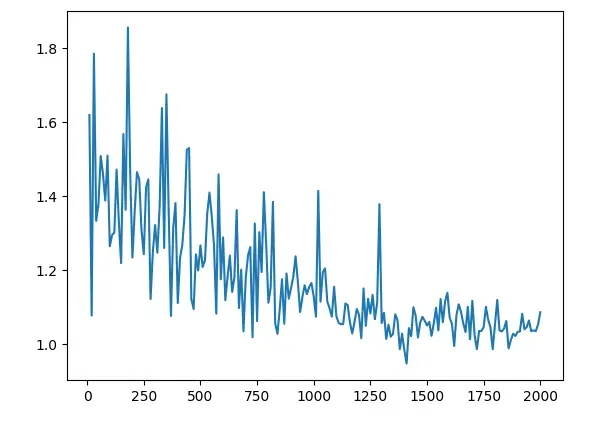
我们现在可以分析结果。我们能看到的第一件事是损失从1.6左右开始,并以接近1的数字结束。看到模型的实际运行情况将是有趣的。现在是我们在模型之前没见过的图像上测试我们的模型的部分。与之前一样,我们使用我们的自定义数据集类创建了一个 Siamese Network 数据集,但现在我们将其指向测试文件夹。
作为接下来的步骤,我们从第一批中提取第一张图像,并迭代5次以提取接下来5批中的5张图像,因为我们设置每批包含一张图像。然后,使用 torch.cat() 水平组合两个图像,我们可以清楚地可视化哪个图像与哪个图像进行了比较。
我们将两个图像传入模型并获得两个向量,然后将这两个向量传入 F.pairwise_distance() 函数,这将计算两个向量之间的欧氏距离。使用这个距离,我们可以作为衡量两张脸有多不相似的指标。
test_loader_one = DataLoader(test_dataset, batch_size=1, shuffle=False)dataiter = iter(test_loader_one)x0, _, _ = next(dataiter)for i in range(5):# Iterate over 5 images and test them with the first image (x0)_, x1, label2 = next(dataiter)# Concatenate the two images togetherconcatenated = torch.cat((x0, x1), 0)output1, output2 = net(x0.cuda(), x1.cuda())euclidean_distance = F.pairwise_distance(output1, output2)imshow(torchvision.utils.make_grid(concatenated), f'Dissimilarity: {euclidean_distance.item():.2f}')view raweval.py hosted with ❤ by GitHub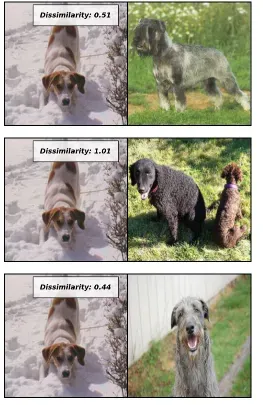
总结
Siamese 网络与对比损失结合,为学习图像相似性提供了一个强大而有效的框架。通过对相似和不相似图像进行训练,这些网络可以学会提取能够捕捉基本视觉特征的判别性embedding。对比损失函数通过优化embedding空间进一步增强
了模型准确测量图像相似性的能力。随着深度学习和计算机视觉的进步,Siamese 网络在各个领域都有着巨大的潜力,包括图像搜索、人脸验证和推荐系统。通过利用这些技术,我们可以为基于内容的图像检索、视觉理解以及视觉领域的智能决策开启令人兴奋的可能性。
The above is the detailed content of Exploring Siamese networks using contrastive loss for image similarity comparison. For more information, please follow other related articles on the PHP Chinese website!

Hot AI Tools

Undresser.AI Undress
AI-powered app for creating realistic nude photos

AI Clothes Remover
Online AI tool for removing clothes from photos.

Undress AI Tool
Undress images for free

Clothoff.io
AI clothes remover

AI Hentai Generator
Generate AI Hentai for free.

Hot Article

Hot Tools

Notepad++7.3.1
Easy-to-use and free code editor

SublimeText3 Chinese version
Chinese version, very easy to use

Zend Studio 13.0.1
Powerful PHP integrated development environment

Dreamweaver CS6
Visual web development tools

SublimeText3 Mac version
God-level code editing software (SublimeText3)

Hot Topics
 1377
1377
 52
52
 Bytedance Cutting launches SVIP super membership: 499 yuan for continuous annual subscription, providing a variety of AI functions
Jun 28, 2024 am 03:51 AM
Bytedance Cutting launches SVIP super membership: 499 yuan for continuous annual subscription, providing a variety of AI functions
Jun 28, 2024 am 03:51 AM
This site reported on June 27 that Jianying is a video editing software developed by FaceMeng Technology, a subsidiary of ByteDance. It relies on the Douyin platform and basically produces short video content for users of the platform. It is compatible with iOS, Android, and Windows. , MacOS and other operating systems. Jianying officially announced the upgrade of its membership system and launched a new SVIP, which includes a variety of AI black technologies, such as intelligent translation, intelligent highlighting, intelligent packaging, digital human synthesis, etc. In terms of price, the monthly fee for clipping SVIP is 79 yuan, the annual fee is 599 yuan (note on this site: equivalent to 49.9 yuan per month), the continuous monthly subscription is 59 yuan per month, and the continuous annual subscription is 499 yuan per year (equivalent to 41.6 yuan per month) . In addition, the cut official also stated that in order to improve the user experience, those who have subscribed to the original VIP
 Context-augmented AI coding assistant using Rag and Sem-Rag
Jun 10, 2024 am 11:08 AM
Context-augmented AI coding assistant using Rag and Sem-Rag
Jun 10, 2024 am 11:08 AM
Improve developer productivity, efficiency, and accuracy by incorporating retrieval-enhanced generation and semantic memory into AI coding assistants. Translated from EnhancingAICodingAssistantswithContextUsingRAGandSEM-RAG, author JanakiramMSV. While basic AI programming assistants are naturally helpful, they often fail to provide the most relevant and correct code suggestions because they rely on a general understanding of the software language and the most common patterns of writing software. The code generated by these coding assistants is suitable for solving the problems they are responsible for solving, but often does not conform to the coding standards, conventions and styles of the individual teams. This often results in suggestions that need to be modified or refined in order for the code to be accepted into the application
 Can fine-tuning really allow LLM to learn new things: introducing new knowledge may make the model produce more hallucinations
Jun 11, 2024 pm 03:57 PM
Can fine-tuning really allow LLM to learn new things: introducing new knowledge may make the model produce more hallucinations
Jun 11, 2024 pm 03:57 PM
Large Language Models (LLMs) are trained on huge text databases, where they acquire large amounts of real-world knowledge. This knowledge is embedded into their parameters and can then be used when needed. The knowledge of these models is "reified" at the end of training. At the end of pre-training, the model actually stops learning. Align or fine-tune the model to learn how to leverage this knowledge and respond more naturally to user questions. But sometimes model knowledge is not enough, and although the model can access external content through RAG, it is considered beneficial to adapt the model to new domains through fine-tuning. This fine-tuning is performed using input from human annotators or other LLM creations, where the model encounters additional real-world knowledge and integrates it
 Seven Cool GenAI & LLM Technical Interview Questions
Jun 07, 2024 am 10:06 AM
Seven Cool GenAI & LLM Technical Interview Questions
Jun 07, 2024 am 10:06 AM
To learn more about AIGC, please visit: 51CTOAI.x Community https://www.51cto.com/aigc/Translator|Jingyan Reviewer|Chonglou is different from the traditional question bank that can be seen everywhere on the Internet. These questions It requires thinking outside the box. Large Language Models (LLMs) are increasingly important in the fields of data science, generative artificial intelligence (GenAI), and artificial intelligence. These complex algorithms enhance human skills and drive efficiency and innovation in many industries, becoming the key for companies to remain competitive. LLM has a wide range of applications. It can be used in fields such as natural language processing, text generation, speech recognition and recommendation systems. By learning from large amounts of data, LLM is able to generate text
 To provide a new scientific and complex question answering benchmark and evaluation system for large models, UNSW, Argonne, University of Chicago and other institutions jointly launched the SciQAG framework
Jul 25, 2024 am 06:42 AM
To provide a new scientific and complex question answering benchmark and evaluation system for large models, UNSW, Argonne, University of Chicago and other institutions jointly launched the SciQAG framework
Jul 25, 2024 am 06:42 AM
Editor |ScienceAI Question Answering (QA) data set plays a vital role in promoting natural language processing (NLP) research. High-quality QA data sets can not only be used to fine-tune models, but also effectively evaluate the capabilities of large language models (LLM), especially the ability to understand and reason about scientific knowledge. Although there are currently many scientific QA data sets covering medicine, chemistry, biology and other fields, these data sets still have some shortcomings. First, the data form is relatively simple, most of which are multiple-choice questions. They are easy to evaluate, but limit the model's answer selection range and cannot fully test the model's ability to answer scientific questions. In contrast, open-ended Q&A
 Five schools of machine learning you don't know about
Jun 05, 2024 pm 08:51 PM
Five schools of machine learning you don't know about
Jun 05, 2024 pm 08:51 PM
Machine learning is an important branch of artificial intelligence that gives computers the ability to learn from data and improve their capabilities without being explicitly programmed. Machine learning has a wide range of applications in various fields, from image recognition and natural language processing to recommendation systems and fraud detection, and it is changing the way we live. There are many different methods and theories in the field of machine learning, among which the five most influential methods are called the "Five Schools of Machine Learning". The five major schools are the symbolic school, the connectionist school, the evolutionary school, the Bayesian school and the analogy school. 1. Symbolism, also known as symbolism, emphasizes the use of symbols for logical reasoning and expression of knowledge. This school of thought believes that learning is a process of reverse deduction, through existing
 SOTA performance, Xiamen multi-modal protein-ligand affinity prediction AI method, combines molecular surface information for the first time
Jul 17, 2024 pm 06:37 PM
SOTA performance, Xiamen multi-modal protein-ligand affinity prediction AI method, combines molecular surface information for the first time
Jul 17, 2024 pm 06:37 PM
Editor | KX In the field of drug research and development, accurately and effectively predicting the binding affinity of proteins and ligands is crucial for drug screening and optimization. However, current studies do not take into account the important role of molecular surface information in protein-ligand interactions. Based on this, researchers from Xiamen University proposed a novel multi-modal feature extraction (MFE) framework, which for the first time combines information on protein surface, 3D structure and sequence, and uses a cross-attention mechanism to compare different modalities. feature alignment. Experimental results demonstrate that this method achieves state-of-the-art performance in predicting protein-ligand binding affinities. Furthermore, ablation studies demonstrate the effectiveness and necessity of protein surface information and multimodal feature alignment within this framework. Related research begins with "S
 Laying out markets such as AI, GlobalFoundries acquires Tagore Technology's gallium nitride technology and related teams
Jul 15, 2024 pm 12:21 PM
Laying out markets such as AI, GlobalFoundries acquires Tagore Technology's gallium nitride technology and related teams
Jul 15, 2024 pm 12:21 PM
According to news from this website on July 5, GlobalFoundries issued a press release on July 1 this year, announcing the acquisition of Tagore Technology’s power gallium nitride (GaN) technology and intellectual property portfolio, hoping to expand its market share in automobiles and the Internet of Things. and artificial intelligence data center application areas to explore higher efficiency and better performance. As technologies such as generative AI continue to develop in the digital world, gallium nitride (GaN) has become a key solution for sustainable and efficient power management, especially in data centers. This website quoted the official announcement that during this acquisition, Tagore Technology’s engineering team will join GLOBALFOUNDRIES to further develop gallium nitride technology. G



